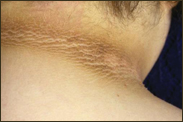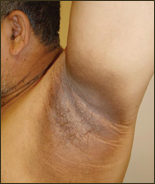The Patient with Metabolic Liver Disease
The Case: A 16-year-old Hispanic boy is seen by his pediatrician for a routine yearly visit. His only symptomatic complaint is mild periumbilical abdominal pain. His main concern is his weight as well as the brownish discoloration of the skin around his neck (Figure 1).
He is active in playing football at school; he eats an age-appropriate diet. Because of his obesity on a physical exam, his pediatrician checks a lab profile.

Key Supporting Information
Lysosomal acid lipase deficiency (LAL-D) is a rare genetic disease with significant morbidity and early mortality. Specifically, LAL-D is an autosomal recessive lysosomal storage disorder that is caused by a marked decrease in the activity of the LAL enzyme due to mutations affecting the LIPA gene. Significant morbidity and early mortality is often associated with the disease due to the marked decrease of LAL enzyme activity, which results in the accumulation of lipid substrates in various tissues and cell types, primarily in the hepatic, gastrointestinal, and cardiovascular systems.
LAL-D is sometimes referred to as:
- Wolman disease (early-onset LAL deficiency)
- Cholesteryl ester storage disease or CESD (late-onset LAL deficiency)
- Acid cholesteryl ester hydrolase deficiency, Type 2
- Acid lipase disease
- Cholesteryl ester hydrolase deficiency storage disease
- LIPA deficiency
The age at onset and rate of progression vary greatly and this may relate to the nature of the underlying mutations. Patients presenting in infancy have the most rapidly progressive disease, developing signs and symptoms in the first weeks of life and rarely surviving beyond 6 months of age. Children and adults typically present with some combination of dyslipidemia, hepatomegaly, elevated transaminases, and microvesicular hepatosteatosis on biopsy. Dyslipidemia is a characteristic feature of LAL-D in children and adults, and many patients are likely to be referred to lipid clinics before diagnosis.
Liver damage with progression to fibrosis, cirrhosis, and liver failure occurs in a large proportion of patients. Elevated low-density lipoprotein cholesterol levels and decreased high-density lipoprotein cholesterol levels are common features, and cardiovascular disease may manifest as early as childhood. Given the similarities between the lipid profile observed in patients with LAL-D and that of common genetic hyperlipidemias such as hereditary familial hypercholesterolemia (HeFH) and familial combined hyperlipidemia (FCH), it is important that clinicians remain vigilant to avoid misdiagnosis. Given that these clinical manifestations are shared with other cardiovascular, liver, and metabolic diseases, it is not surprising that LAL-D is underrecognized in clinical practice.
Wolman Disease has a reported incidence of 1:500,000 and is rapidly progressive and fatal. In addition to hepatomegaly and liver failure, other defining symptoms include splenomegaly, persistent vomiting and diarrhea, abdominal distention, and profound growth failure. Adrenal calcification is frequently present. There are no approved treatments, only palliative care.
CESD has an estimated range of prevalence from 25 in 1 million to as high as 1 in 40,000. The significant difference in estimates is most likely due to underdiagnosis. Although it is rare, it is likely that many patients are unrecognized or misdiagnosed. Education about common symptoms of CESD as well as a higher level of suspicion for screening for CESD will lead to earlier diagnosis. Patients with CESD may often be misdiagnosed because symptoms may be nonspecific. Symptoms may present in infancy if there is complete loss of lysosomal acid lipase or in early childhood or adulthood when there is partial loss.
CESD is similar to other lysosomal storage disorders such as Gaucher, Fabry and Pompe. As stated, CESD presents with prominent hepatic manifestations, lipid disorders, and cardiovascular involvement. The deficiency in LAL predominantly results in cholesteryl ester accumulation, particularly in the liver, spleen, and macrophages throughout the body. On liver biopsy, the microvesicular steatosis may be misdiagnosed as nonalcoholic steatohepatitis, nonalcoholic fatty liver disease, or cryptogenic liver disease. One case of CESD appeared in a 13-year-old boy with mildly elevated liver enzymes in the absence of hepatomegaly. This pediatric case, confirmed by genetics and biopsy, suggests that this diagnosis can be easily missed. Definitive diagnosis is key and should include the most sensitive and specific assays and methodologies.
The histologic diagnosis of LAL-D is facilitated by immunostaining for the lysosomal protein cathepsin D, which is routinely performed in many pathology laboratories. Measurement of LAL using dried blood spots (DBS) is made difficult by the presence of other lipases in whole blood. Lalistat is a specific inhibitor of LAL that allows the determination of LAL in DBS. Results show the method differentiates clearly between normal controls, carriers, and affected cases.
Current management of LAL-D focuses on lipid control and amelioration of liver complications. Supportive treatment has included cholestyramine, statins, and ultimately, liver transplantation. Treatment with statins does not reverse the disease manifestations, which lead to liver failure. The limited success of statins in treating all aspects of LAL-D means that alternative, disease-specific treatments are needed. The ongoing development of sebelipase alfa, an investigational enzyme replacement, offers a disease-specific therapeutic approach that may change the natural course of the disease. In patients with CESD, sebelipase alfa has been found to be well tolerated, and rapidly decreases serum transaminases. These improvements are sustained with long-term dosing and are accompanied by improvements in serum lipid profile.

There is a need for enhanced awareness of LAL-D so that early diagnosis can help limit disease-associated morbidity and mortality. Clinicians are likely to be confronted with LAL-D in clinical practice and should be aware of the hallmarks of the disease. Differential diagnosis is key because a number of other conditions have similar clinical and laboratory presentations. Early recognition and diagnosis of individuals with LAL-D is essential if appropriate care is to be provided. The recent development of a blood test for LAL-D provides physicians with a method for rapid diagnosis. Emerging options for treatment may lessen the burden of this life-limiting disease.
Fatty liver is the most common cause of liver disease, even in children. Insulin resistance is thought to underlie the accumulation of fat in the liver, but other factors such as oxidant injury contribute to the fact that some individuals may have isolated steatosis without any liver injury, while others can progress to steatohepatitis or even cirrhosis. Acanthosis nigricans is a skin condition characterized by areas of dark, velvety discoloration in body folds and creases that is associated with insulin resistance. The affected skin can become thickened and may be malodorous, affecting the armpits, groin, and neck (Figure 2).
Click here to see this Education Lab Activity.
Learning Objectives
Upon successful completion of this educational activity, participants should be better able to assess lysosomal acid lipase deficiency and other metabolic liver diseases.
Overview
Author(s)/Faculty: Ronald A. Codario, MD, FACP, FNLA, RPVI, CCMEP
Source: Healio Gastroenterology Education Lab
Type: Monograph
Articles/Items: 4
Release Date: 8/15/2015
Expiration Date: 8/15/2016
Credit Type: CME
Number of Credits: 0.25
Cost: Free
Provider: Vindico Medical Education
CME Information
Provider Statement: This continuing medical education activity is provided by Vindico Medical Education.
Support Statement: No commercial support for this activity.
Target Audience: The target audience for this activity is gastroenterologists and other health care professionals with an interest in the treatment of patients with gastroenterological disorders.
